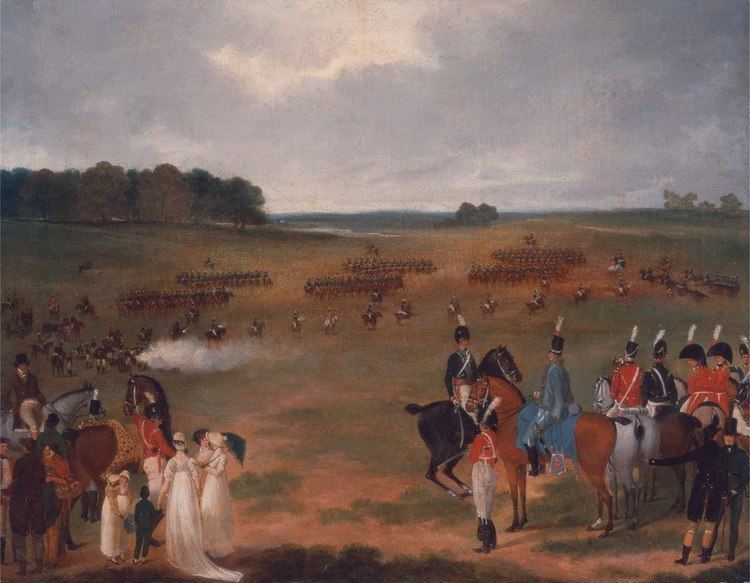 | ||
Yeomanry is a designation used by a number of units or sub-units of the British Army Reserve, descended from volunteer cavalry regiments. Today, Yeomanry units serve in a variety of different military roles.
Contents
Origins
In the 1790s, the threat of invasion of the Kingdom of Great Britain was high, after the French Revolution and the rise of Napoleon Bonaparte. To improve the country's defences, volunteer regiments were raised in many counties from yeomen. While the word "yeoman" in normal use meant a small farmer who owned his land, Yeomanry officers were drawn from the nobility or the landed gentry, and many of the men were the officers' tenants or had other forms of obligation to the officers. These regiments became known collectively as the Yeomanry. Members of the yeomanry were not obliged to serve overseas without their individual consent.
Early 19th century
During the first half of the nineteenth century Yeomanry Regiments were used extensively in support of the civil authority to quell riots and civil disturbances, including the Peterloo Massacre; as police forces were created and took over this role, the Yeomanry concentrated on local defence. In 1827 it was decided for financial reasons to reduce the number of yeomanry regiments, disbanding those which had not been required to assist the civil power over the previous decade. A number of independent troops were also dissolved. Following these reductions the yeomanry establishment was fixed at 22 corps (regiments) receiving allowances and a further 16 serving without pay.
During the 1830s the number of yeomanry units fluctuated, reflecting the level of civil unrest in any particular region at any particular time. The Irish Yeomanry, which had played a major role in suppressing the rebellion of 1798, was completely disbanded in 1838.
Mid and late 19th century
For the next thirty years the Yeomanry Force was retained as a second line of support for the regular cavalry within Britain. Recruiting difficulties led to serious consideration being given to the disbandment of the entire force in 1870, but instead measures were taken the following year to improve its effectiveness. These included requirements that individual yeomanry troopers attend a minimum number of drills per year in return for a "permanent duty" allowance, and that units be maintained at a specific strength. Yeomanry officers and permanent drill instructors were required to undergo training at a newly established School of Instruction and the Secretary of State for War took over responsibility for the force, from individual Lords Lieutenant of counties. While these reforms improved the professionalism of the Yeomanry Force, numbers remained low (only 10,617 in 1881).
In 1876 the role of the Yeomanry Force was fixed as that of light cavalry. During the previous decades horse artillery troops had been raised to be attached to a number of yeomanry regiments and dismounted detachments appeared where horses were not available in sufficient numbers. These supernumerary units were now abolished.
Boer War
During the Second Boer War companies of Imperial Yeomanry were formed to serve overseas from volunteers from the Yeomanry. In 1901 all yeomanry regiments were redesignated as "Imperial Yeomanry", and reorganised. In 1908 the Imperial Yeomanry was merged with the Volunteer Force to form the Territorial Force, of which it became the cavalry arm. The "Imperial" title was dropped at the same time.
World War I and later
On the eve of World War I in 1914 there were 55 Yeomanry regiments (with two more formed in August 1914), each of four squadrons instead of the three of the regular cavalry. Upon embodiment these regiments were either brought together to form mounted brigades or allocated as divisional cavalry. For purposes of recruitment and administration the Yeomanry were linked to specific counties or regions, identified in the regimental title. Some of the units still in existence in 1914 dated back to those created in the 1790s while others had been created during a period of expansion following on the Boer War. After the First World War the Territorial Force was disbanded and later reformed and redesignated as the Territorial Army. Following the experience of the war, only the fourteen senior yeomanry regiments retained their horses, with the rest being re-roled as armoured car companies, artillery, engineers, or signals. Two regiments were disbanded. The converted units retained their yeomanry traditions, with some artillery regiments having individual batteries representing different yeomanry units.
World War II
On the eve of the Second World War in 1939 the Territorial Army was doubled in size, with duplicate units formed; this led to some regiments being de-amalgamated. The last mounted regiment of yeomanry was the Queen's Own Yorkshire Dragoons, who were converted to an armoured role in March 1942, and later converted again into an infantry battalion of the King's Own Yorkshire Light Infantry. Volunteers from the Yeomanry served in the Long Range Desert Group from 1940 through to 1943, incorporated into "Y Patrol".
Post-war
There were reductions in the size of the TA in 1957 and 1961 and this led to amalgamation of some pairs of yeomanry regiments. There was a major reduction in reserve forces in 1967 with the formation of the Territorial and Army Volunteer Reserve, and all existing yeomanry regiments were reduced to squadron, company or battery sub-units. A number of further reorganisations have taken place since then.
Current Yeomanry regiments
In the current Army Reserve there remain remnants of former Yeomanry regiments serving, usually as a sub-unit that is part of a larger unit:
